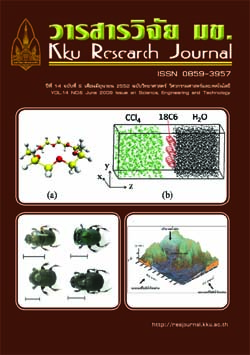Feasibility study of irrigation development project from groundwater resources at Na Nong Thum sub-district, Chum Phae district, Khon Kaen province (Thai)
Main Article Content
Abstract
The objective of the project on the feasibility study of an irrigation development project from groundwater resources at Na Nong Thum Sub-district, Chum Phae District, Khon Kaen Province was to study the quantity and quality of groundwater resources, the irrigation system development cost and its effectiveness. Na Noung Thum Sub-district has a population of 9,000 with 48 km2 of agricultural area. The data in this study were compiled from basic existing information and additional field investigation. The storage volume and safe yield of the groundwater resources were determined from pumping tests, groundwater quality classification and applying a numerical groundwater model. Moreover, water demand for plants, irrigation systems, and analysis of net present value, NPV, were also subsequently evaluated. The critical point for this study is the cost effectiveness, which was calculated on the basis of net present value and internal rate of return (IRR). Results of the study show that all of the three major parts are feasible. Total groundwater storage in the limestone aquifer is approximately 200 million cubic meters, and the groundwater recharge is about 10 million cubic meters/year. This indicates that the water demand in the dry season of about 4.8 million cubic meters/year might not be result in water balance for the area. The water quality was classified as irrigation, livestock, and drinking water. The irrigation system was designed in two parts. The headwork system was designed to collect groundwater from springs by pumping systems. The high gradient headwork distributed water with gravity flow, which saves energy and cost. The water distributing system was designed as a piping system, which could be connected to the existing surface water canal. The irrigation system was designed in three phases with investment cost of 40, 25, and 25 million baht, respectively. The cost effectiveness study was conducted by assuming the project duration of 20 years with 7% discount rate. The result shows that the project is economically feasible for investment and could give a return in the eighth year.


